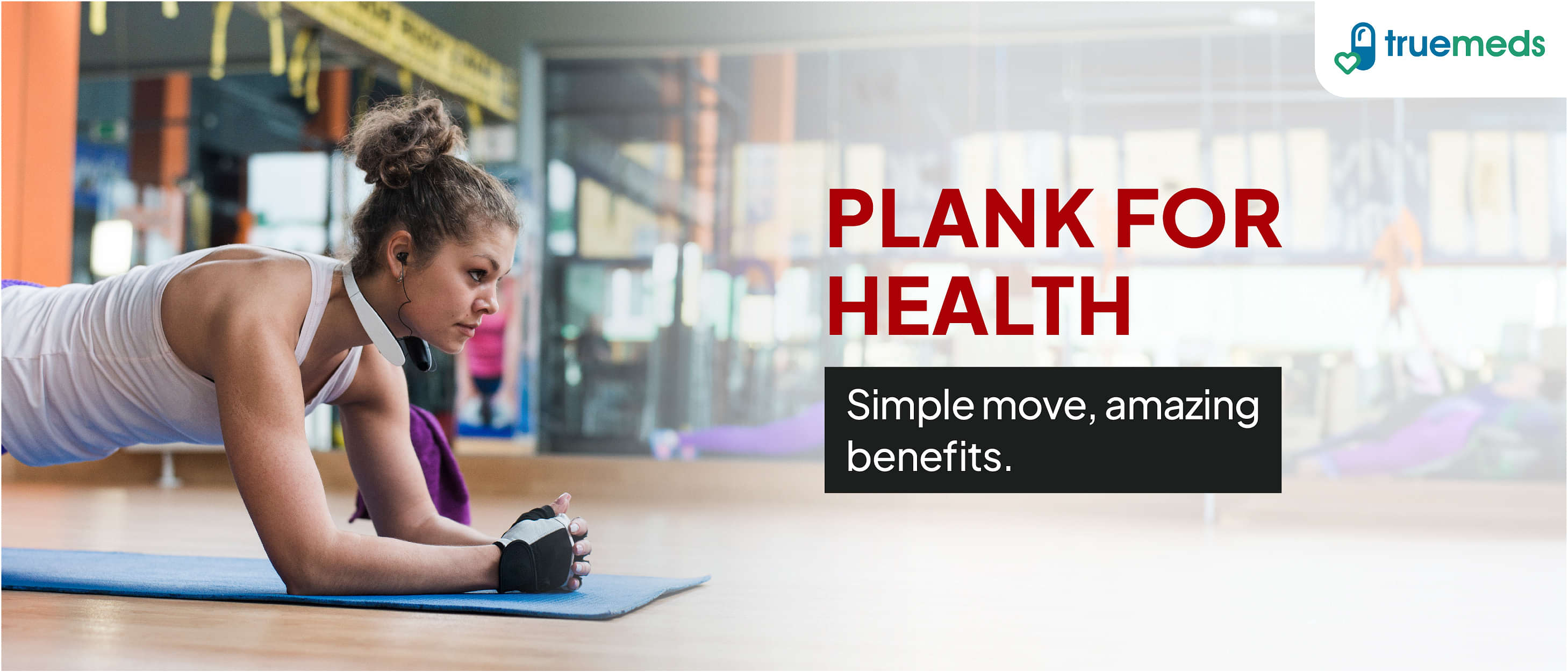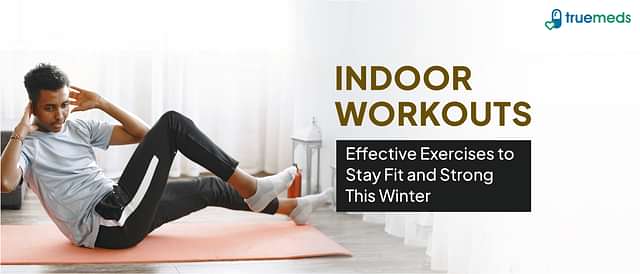Health Benefits Of Doing The Plank Exercise Every Day
Last updated on : 01 Dec, 2025
Read time : 8 min
What is Plank Exercise?
The plank exercise, also known as phalakasana in yoga, involves holding a position similar to the top of a push-up with your body straight and parallel to the ground. It primarily targets your core muscles, including the rectus abdominis, obliques, and transverse abdominis. Planks are popular for their simplicity, convenience, and effectiveness in building isometric core strength and endurance. They require no equipment and can be done anywhere. Incorporating planks into your daily routine, with focus on proper form to prevent strain, can improve posture, prevent injuries, and enhance overall functional fitness. So, next time you’re looking for a quick and impactful exercise, consider adding planks to your regimen!
Key Benefits of Regular Plank Practice
1. Improves Body Balance and Posture by Strengthening the Core
Planking works wonders for stability and posture. Engaging the deep core muscles during planks helps to stabilise the spine and pelvis, which is essential for improved overall balance and alignment [1]. This enhanced stability results in a stronger foundation for the body. A strong core developed from regular planking can positively impact your posture while sitting at a desk or standing, reducing strain on your back and neck.
2. Builds Core Muscle Strength and Endurance
Planks are a highly effective exercise for building isometric strength and endurance in the core. By holding the static plank position, you maximally engage the rectus abdominis, obliques, and transverse abdominis. This type of training not only enhances abdominal definition but, more importantly, provides crucial support for the spine, which can improve athletic performance and decrease the risk of back issues [2].
3. Supports Spinal Stability and May Alleviate Back Discomfort
Planks may offer benefits for reducing non-specific chronic low back discomfort by targeting and strengthening the muscles that support spinal stability, including the core, shoulders, and glutes [2]. Strengthening these support muscles is a key non-pharmacological strategy for managing and potentially alleviating back pain. Core engagement during planks also helps reinforce the improved posture, which reduces unnecessary strain on the lower back during daily activities like sitting, standing, or lifting objects. It is crucial to maintain a neutral spine (avoiding hip sag or excessive arching) to gain this benefit safely.
4. Contributes to Overall Functional Fitness and Metabolism
While often considered a core exercise, the plank engages multiple muscle groups simultaneously, including the arms, chest, shoulders, abdominals, back, and legs. This compound isometric movement provides a total-body challenge. By increasing overall lean muscle mass, regular planking can contribute to a higher resting metabolic rate, which supports weight management [3]. Consistent practice enhances energy levels and general physical fitness by improving the body’s ability to sustain effort.
Essential Variations of the Plank Exercise for Progress
Plank variations, such as side planks and forearm planks, are designed to target different muscle groups more intensely, enhancing overall strength and stability. These variations can be more challenging as they require greater balance and control. They are excellent for progressing your fitness level and preventing workout monotony.
1. Front, Side, and Reverse Planks
- Front Plank (Basic):
- Assume a push-up position with your forearms on the ground, elbows directly beneath the shoulders.
- Keep your body in a straight line from the back of your head to your heels, engaging your core and squeezing your glutes.
- Hold for a chosen duration (e.g., 30 seconds).
- Side Plank:
- Lie on your side, legs extended and stacked, supporting yourself on your elbow and forearm.
- Lift your hips until your body forms a straight diagonal line. Engage your obliques (side abdominal muscles) and hold.
- Reverse Plank:
- Sit on the floor, legs extended. Place your palms behind you with fingers pointing towards your feet.
- Lift your hips and torso upward, forming a straight line from your shoulders to your heels. Avoid letting the head drop back. Hold the position.
2. The Plank Endurance Test
The plank endurance test assesses core muscle static strength and endurance. To perform it:
- Assume a standard plank position with elbows on the ground, legs straight, and weight on toes.
- Lift your hips to create a straight, neutral line from your head to your heels.
- Hold for as long as possible with perfect form.
- According to some fitness benchmarks, excellent scores exceed 4 minutes, very good scores are 2-4 minutes, and average scores are 1-2 minutes for adults.
3. Arm or Leg Lift Planks (Dynamic Stability Challenge)
These are variations of the standard plank that enhance dynamic core stability—the ability of the core to resist rotation.
- Arm Lift Plank:
- Start in a plank position (forearms or palms).
- Lift one arm straight out in front of you (or to the side) while maintaining a perfectly straight and stable torso.
- Alternate arms for a set number of repetitions. Focus intensely on preventing hip rotation.
- Leg Lift Plank:
- Hold the standard plank position.
- Raise one leg 5-8 inches off the floor without changing the alignment of your hips.
- Hold briefly, then switch legs. Aim for 3 sets of 10 repetitions (5 per leg). Control is more important than speed or height.
4. Side Plank Crunch
This variation focuses on strengthening the obliques (side core muscles).
- Lie on your side in a side plank position with your knees bent (modification for beginners) or legs straight.
- Place your top hand behind your head.
- Maintain the straight side plank while bringing your top elbow and top knee together in a crunch motion.
- Slowly return to the starting position. Repeat for 10-15 reps on each side.
5. Resistance Plank
The resistance plank incorporates external load (e.g., a weighted plate placed on the upper back or a resistance band around the feet/ankles) to intensify the core-strengthening challenge. This is an advanced variation and should only be attempted by those who can comfortably hold the basic plank with perfect form for over 60 seconds to avoid putting excessive, unsafe pressure on the spine.
How to do the Plank Exercise with Proper Form
Here’s a concise step-by-step guide to perform the basic forearm plank safely:
- Set Up (Starting Position): Begin on all fours.
- Position Arms: Lower down to rest on your elbows. Ensure your elbows are directly beneath your shoulders and your forearms are parallel.
- Extend Your Feet: Walk your feet back until your entire body is elongated into a straight line. Your weight should be on your forearms and toes.
- Body Alignment (The Key): Engage your glutes and squeeze your abdominal muscles (pull your belly button toward your spine). Your body must form a straight line from the crown of your head to your heels. Avoid letting your hips sag or pushing them up into an inverted ‘V’ shape.
- Hold: Sustain the position while concentrating on maintaining perfect form.
- Breath: Do not hold your breath. Maintain slow, steady, diaphragmatic breathing.
- Progression: Start by holding for 20-30 seconds, gradually increasing the duration as your strength and form allow.
Conclusion
Adding the plank exercise to your daily routine, when performed with correct technique and consistency, offers a range of evidence-based health benefits. It is a powerful exercise for strengthening your core, improving postural stability, and potentially easing low back discomfort [2]. Because it engages multiple muscle groups, it also contributes significantly to your overall functional fitness and endurance [3]. Remember that the focus should always be on maintaining perfect form rather than holding for the longest possible time to ensure safety and maximize benefit.
Expert Quote
“Planks are one of the most efficient, low-impact, full-body exercises that take just a few minutes of your day but, when done correctly, can significantly improve core stability, enhance posture, and build whole-body endurance.”
– Dr. Anubha Karol (A credentialed expert)
Frequently Asked Questions (FAQs)
What happens if I plank every day?
Planking every day can significantly strengthen your core and deep stabilising muscles, leading to improved posture, better balance, and enhanced overall stability [1]. As a compound exercise, it also contributes to muscle endurance throughout the body, but it should be part of a balanced routine that includes dynamic and cardiovascular work for optimal health benefits.
What will 30 days of planking do?
A 30-day planking challenge can demonstrably improve core endurance and static strength. By gradually increasing the duration and/or introducing variations, it builds muscle definition and stamina in the abs, back, and shoulders. Participants often report a noticeable improvement in their ability to maintain proper posture for longer periods and a reduction in minor, non-specific back pain [2].
Do planks burn belly fat?
Planks are excellent for strengthening and toning the core muscles, but they are primarily an isometric strength exercise, not a high-calorie-burning cardio exercise. The plank exercise’s benefit for fat loss is indirect: by building muscle mass, they help increase your resting metabolism over time [3]. Reducing belly fat requires a holistic approach that combines regular cardiovascular exercise, a balanced, calorie-controlled diet, and full-body strength training.
References
[1] Hung, K.-C., Chung, H.-W., Yu, C. C.-W., Lai, H.-C., & Sun, F.-H. (2019). Effects of 8-week core training on core endurance and running economy. PLOS ONE, 14(3), e0213158. https://doi.org/10.1371/journal.pone.0213158
[2] Gordon, R., & Bloxham, S. (2016). A systematic review of the effects of exercise and physical activity on non-specific chronic low back pain. Healthcare, 4(2), 22. https://doi.org/10.3390/healthcare40200022
[3] Anand, S., & Samuel, A. J. (2021). Effectiveness of modified plank vs conventional plank on core muscle endurance and stability in recreational athletes: A quasi-experimental study. ResearchGate. https://www.researchgate.net/publication/354143568_Effectiveness_of_Modified_Plank_vs_Conventional_Plank_on_Core_Muscle_Endurance_and_Stability_in_Recreational_Athletes_A_Quasi-Experimental_study
Disclaimer
Our healthcare experts have carefully reviewed and compiled the information presented here to ensure accuracy and trustworthiness. It is important to note that this information serves as a general overview of the topic and is for informational purposes only. It is not intended to diagnose, prevent, or cure any health problem. This page does not establish a doctor-patient relationship, nor does it replace the advice or consultation of a registered medical practitioner. We recommend seeking guidance from your registered medical practitioner for any questions or concerns regarding your medical condition.
Popular Articles
Recommended Articles
Recent Articles
Company
About UsHealth ArticleHealth StoriesHealth LibraryDiseases & Health ConditionsAyurvedaUnderstanding Generic MedicinesAll MedicinesAll BrandsNeed HelpFAQSecuritySubscribe
Registered Office Address
Grievance Officer
Download Truemeds
Contact Us
Our customer representative team is available 7 days a week from 9 am - 9 pm.
v4.10.1
2025 - Truemeds | All rights reserved. Our content is for informational purposes only. See additional information.
Our Payment Partners













































